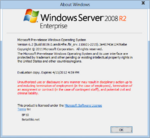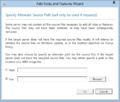Windows Server 2012 build 8019
| Build of Windows Server 2012 | |
 | |
| OS family | Windows NT |
|---|---|
| Version number | 6.2 |
| Build number | 8019 |
| Build revision | 0 |
| Architecture | x64 |
| Build lab | fbl_srv |
| Compiled on | 2011-06-01 |
| Expiration date | |
| Timebomb | 2012-04-15 (+319 days) |
| About dialog | |
Windows Server 2012 build 8019 is a build of Windows Server 2012, which was shared on 11 April 2024.
Editions and keys[edit | edit source]
| Edition / SKU Name | Key |
|---|---|
Standard Server (ServerStandard)
|
HMG6P-C7VGP-47GJ9-TWBD4-2YYCD |
Enterprise Server (ServerEnterprise)
|
7P8GH-FV2FF-8FDCR-YK49D-D7P97 |
Datacenter Server (ServerDatacenter)
|
7X29B-RDCR7-J6R29-K27FF-H9CR9 |
Web Server (ServerWeb)
|
YGTGP-9XH8D-8BVGY-BVK4V-3CPRF |
| Upgradable editions[a] | |
Standard Server Evaluation (ServerStandardEval)
|
G3KNM-CHG6T-R36X3-9QDG6-8M8K9 |
Datacenter Server Evaluation (ServerDatacenterEval)
|
NXCTR-YXXWC-TK368-HGGTF-8YB99 |
Foundation Server (ServerWinFoundation)[b]
|
36RXV-4Y4PJ-B7DWH-XY4VW-KQXDQ |
Aurora (Essentials/Small Business Server "8") (ServerSolution)[b]
|
Y7GVM-YFQQW-HV8HW-GRW6D-YJ84M |
MultiPoint Server Standard (ServerMultiPointStandard)
|
HNGCC-Y38KG-QVK8D-WMWRK-X86VK |
MultiPoint Server Premium (ServerMultiPointPremium)
|
P3D2M-NP6MR-JYPD4-WRRT4-W3P7K |
Storage Server Standard (ServerStorageStandard)
|
VQ7FC-RTNC8-RHDFR-8THVR-J633X |
Storage Server Workgroup (ServerStorageWorkgroup)
|
N3FPV-KQP4R-4M6H6-7Q8TK-HYMDX |
High-Performance Computing Server Core (ServerHPC)[b]
|
Q7PRR-M2WBM-RJJ99-FG393-MGY3B |
Storage Server Essentials (ServerHomeStandard)[b]
|
MCQYD-2TJYQ-JP7KR-7GYYF-YGPXQ |
Home Server (ServerHomePremium)[b]
|
4BWDV-9MKGX-V9QJ4-YWFWR-P6974 |
Small Business Server Standard (ServerSBSStandard)[b]
|
YMFM8-J2RV2-66G78-XPQ7C-4RY3B |
Small Business Server Premium (ServerSBSPremium)[b]
|
BXQQP-Q6Q6D-TR7TR-3YXQW-VFHKM |
Windows Server 2008 for Windows Small Business Server (ServerWinSB)[b]
|
JG43G-CMPHG-VPBC6-9TDQR-RRFJ4 |
Windows Server 2008 without Hyper-V for Windows Small Business Server (ServerWinSBV)[b]
|
WQG3Q-VWT72-VX39Q-VRTRD-2RF7K |
ServerEmbeddedSolution[b]
|
M2KD2-F2333-Q3TJ8-BQMHX-9PWX6 |
ServerForSBSolutions[b]
|
PHYFD-HQ4XW-78PR4-2CXKF-V67KJ |
ServerForSBSolutionsEM[b]
|
JR4Y2-WC84X-PBRDJ-QTBTB-TQGGH |
ServerSolutionEM[b]
|
WF9T8-VT7D2-GD629-WTKGH-3WBJT |
ServerSolutionsPremium[b]
|
CWJXK-RG46Y-GDWB3-HQVTQ-JJRTV |
New features and changes[edit | edit source]
Features on Demand[edit | edit source]
This is the earliest available build of Windows Server to include the Remotified installation option (later called Features on Demand in late development builds), which consists of a full, lightweight Windows Server install featuring only the base server operating system and graphical user interface components, for use in networked deployments. Installing additional roles and features on the server will require the user to source the needed components from elsewhere, such as via Windows Update, from a local network share, or through external installation media.
Remotified installations are not available for Web Server.
Boot Graphics Library[edit | edit source]
Fade animation code for transitioning into GUI mode has been implemented.
Client user interface[edit | edit source]
The user interface has seen considerable change over the previous available client build. New transition animations for the Metro user interface have been introduced, and additional iconography aligning with the Metro design language have been implemented. Start screen tiles now use a different gradient design, and scrolling through start screen pages now play a smooth scrolling animation. Brighter accent colors are now used on sidebars and action menus, and the correct font size is now used in text controls. New designs for scroll bar controls and drop-down menus have been added, and borders are now wrapped around selected start screen application tiles.
The Start screen now offers a semantic view mode that can be used to quickly navigate around application groups and search categories, and application groups can additionally be selected and individually named. A Windows Live ID can now be directly associated with a user's account via the start screen. Recent search terms are no longer offered to the user when performing a search.
It is now possible to quickly snap applications and/or the desktop view by clicking/tapping and holding down the top edge of the visible screen and dragging the mouse cursor/finger to any side of the screen. Applications and the desktop view can be switched to by dragging the current visible space to the left-hand edge of the screen, and then moving the cursor/finger to the right to switch to another application.
The Immersive Control Panel has been updated to use lighter greys and larger text, and a new page for personalization options has been added. Icons are no longer used when a user types invalid credentials on the logon screen with red warning text taking its place, and buttons in the Security Options (Ctrl+Alt+Del menu) have been resized to better fit in the center of the screen. The View Available Networks UI has also been redesigned to use Metro controls, rather than be based off of plain Win32.
Bugfixes[edit | edit source]
Desktop Window Manager[edit | edit source]
Font anti-aliasing in the Metro user interface has been fixed.
Redpill[edit | edit source]
Charms bar accessibility[edit | edit source]
To enable the right-hand charms bar on a non touchscreen device, open Registry Editor and then navigate to HKEY_CURRENT_USER\Software\Microsoft\Windows\CurrentVersion\ImmersiveShell. Once there, create a DWORD value called CharmBarMode and then set its value to 1.
Bugs and quirks[edit | edit source]
Compatibility[edit | edit source]
Virtualization[edit | edit source]
To install or run this build in VMware Workstation, the hardware compatibility version must be set to versions 8.x/9.x; otherwise, a bugcheck will occur.
EFI boot support[edit | edit source]
As the EFI boot binaries required to boot this build's installation media are not present (as is common for server builds compiled during this time), the operating system must instead be manually imaged and made bootable, or the media should be rebuilt to include the missing boot files.
Server Manager[edit | edit source]
Servers are not properly accounted for in the Server Manager in most runtime sessions (including the host machine). This bug causes the Add/Remove Roles and Features Wizard and the Server Manager Dashboard to not work properly, as both roles and features will not be detected.
Feature installation[edit | edit source]
Some features such as Active Directory Domain Services and DNS Server will not properly install certain components such as MMC applets, making it virtually impossible to manage them in GUI mode. It is generally advised to use Windows PowerShell commandlets to work around this issue.
Redpill-specific[edit | edit source]
Logon screen[edit | edit source]
Alpha support for branding banner images has not yet been fully implemented at this point in development, resulting in unreadable banner images across all editions.
Gallery[edit | edit source]
Windows Setup[edit | edit source]
Out-of-box experience[edit | edit source]
Interface[edit | edit source]
Un-redpilled[edit | edit source]
Redpill-specific[edit | edit source]
Server Core[edit | edit source]
Interface[edit | edit source]
Redpill-specific[edit | edit source]
Notes[edit | edit source]
- ↑ A majority of these editions can only be installed/upgraded to via the Web Server SKU, which is used as a base for most Windows Server editions (except
ServerHyperCore). Some editions (such as Home Server) require stubbed-out update package manifests for specific components (such as the HomeGroup Control Panel applet) in order to stage and install properly. - ↑ 2.00 2.01 2.02 2.03 2.04 2.05 2.06 2.07 2.08 2.09 2.10 2.11 2.12 2.13 A setup unattend XML file that stages this edition is required in order to be able to upgrade to it.





































